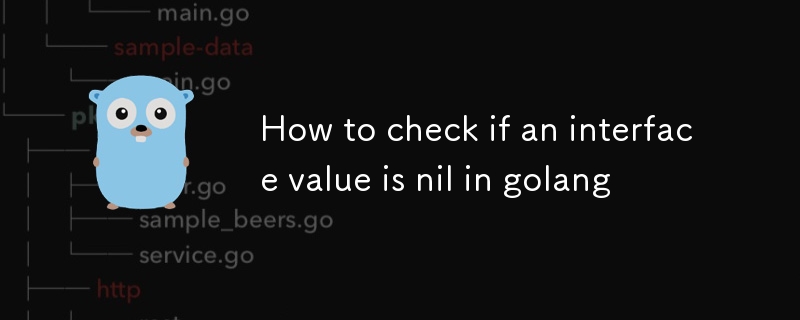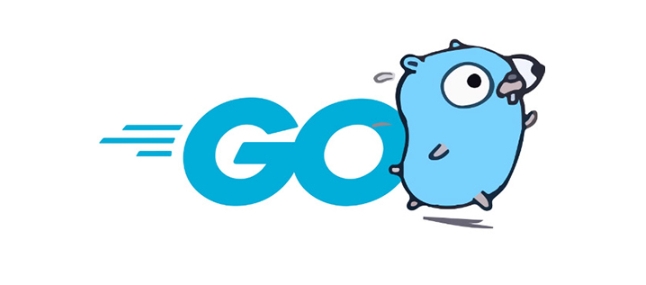In Go language, you need to pay attention to its underlying structure to determine whether the interface is nil. 1. The interface contains type information and value information. The interface is nil only if neither is assigned to the interface; 2. If the specific type of nil is assigned to the interface, the interface is not nil, because the type information is still saved; 3. The correct method is to directly use == nil to judge, which is suitable for most scenarios; 4. The reflection method can be reflected.Value.IsNil(), but attention should be paid to type limitations and panic risks, which are suitable for advanced dynamic processing; 5. It is recommended to avoid assigning specific type nil to the interface, and clarify the document to explain the meaning of nil to ensure that the actual type behind the interface is correctly understood.

In Go, it is not as simple as it seems to determine whether an interface value is nil . Many people think that just using == nil to judge is done, but in fact, you may encounter some situations where "it seems to be nil, but it does not equal nil".

The underlying structure of the interface determines the judgment logic
Go's interface variables actually have two pointers: one pointing to type information and the other pointing to the actual value. That is to say, even if you set a specific value to nil , as long as the type information still exists, the interface variable will not be nil .

For example:
var val *int // val is type *int, the current value is nil
var i interface{} = val
fmt.Println(i == nil) // Output false! The output here is not true , because although val is nil , after assigning the value to the interface, the interface saves *int type information and nil value. In this case, the interface itself is not nil .

Method to correctly determine whether the interface is nil
To determine whether an interface variable is nil , the easiest and safest way is to use == nil directly to compare:
var i interface{}
fmt.Println(i == nil) // true But if you pass in a nil with a specific type (such as *int(nil) ), the result will be false . So the key is: it is the real nil only if the interface variable itself is not assigned any type and value .
Common misunderstandings include:
- Assign a specific type of
nilto an interface, mistakenly thinking that the interface isnil - Don't pay attention to type erasing when using reflection judgment
Reflection method checks whether the interface value is nil (advanced)
If you need to use reflection to determine whether the interface value is nil , you can use reflect.Value.IsNil() method. This method is suitable for processing pointers, interfaces, etc. that can be nil :
var i interface{} = (*int)(nil)
v := reflect.ValueOf(i)
if v.Kind() == reflect.Interface || v.Kind() == reflect.Ptr {
fmt.Println(v.IsNil()) // Output true
}But pay attention to the following points:
- If the incoming primitive type (such as int, string, etc.), calling
IsNil()will panic - You need to first determine whether
Kind()supportsIsNil() - Not recommended for daily basic judgment unless you do need to deal with various types dynamically
Suggestions in actual development
When writing code in daily life, in most cases we only need to make simple == nil judgments, without introducing reflection or other complex logic. More complex means may be required only when dealing with generics, middleware, or framework-layer logic.
A few tips:
- Try to avoid making judgments after assigning specific types of
nilto interface variables. - If the function returns the interface type, make sure the document states clearly what nil means
- When using the interface value returned by a third-party library, pay attention to the real type behind it
Basically that's it. Go's interface nil judgment seems simple, but only after understanding its mechanism can you avoid trampling on pitfalls.
The above is the detailed content of How to check if an interface value is nil in golang. For more information, please follow other related articles on the PHP Chinese website!

Hot AI Tools

Undress AI Tool
Undress images for free

Undresser.AI Undress
AI-powered app for creating realistic nude photos

AI Clothes Remover
Online AI tool for removing clothes from photos.

Clothoff.io
AI clothes remover

Video Face Swap
Swap faces in any video effortlessly with our completely free AI face swap tool!

Hot Article

Hot Tools

Notepad++7.3.1
Easy-to-use and free code editor

SublimeText3 Chinese version
Chinese version, very easy to use

Zend Studio 13.0.1
Powerful PHP integrated development environment

Dreamweaver CS6
Visual web development tools

SublimeText3 Mac version
God-level code editing software (SublimeText3)

Hot Topics
 What are the implications of Go's static linking by default?
Jun 19, 2025 am 01:08 AM
What are the implications of Go's static linking by default?
Jun 19, 2025 am 01:08 AM
Go compiles the program into a standalone binary by default, the main reason is static linking. 1. Simpler deployment: no additional installation of dependency libraries, can be run directly across Linux distributions; 2. Larger binary size: Including all dependencies causes file size to increase, but can be optimized through building flags or compression tools; 3. Higher predictability and security: avoid risks brought about by changes in external library versions and enhance stability; 4. Limited operation flexibility: cannot hot update of shared libraries, and recompile and deployment are required to fix dependency vulnerabilities. These features make Go suitable for CLI tools, microservices and other scenarios, but trade-offs are needed in environments where storage is restricted or relies on centralized management.
 How does Go ensure memory safety without manual memory management like in C?
Jun 19, 2025 am 01:11 AM
How does Go ensure memory safety without manual memory management like in C?
Jun 19, 2025 am 01:11 AM
Goensuresmemorysafetywithoutmanualmanagementthroughautomaticgarbagecollection,nopointerarithmetic,safeconcurrency,andruntimechecks.First,Go’sgarbagecollectorautomaticallyreclaimsunusedmemory,preventingleaksanddanglingpointers.Second,itdisallowspointe
 How do I create a buffered channel in Go? (e.g., make(chan int, 10))
Jun 20, 2025 am 01:07 AM
How do I create a buffered channel in Go? (e.g., make(chan int, 10))
Jun 20, 2025 am 01:07 AM
To create a buffer channel in Go, just specify the capacity parameters in the make function. The buffer channel allows the sending operation to temporarily store data when there is no receiver, as long as the specified capacity is not exceeded. For example, ch:=make(chanint,10) creates a buffer channel that can store up to 10 integer values; unlike unbuffered channels, data will not be blocked immediately when sending, but the data will be temporarily stored in the buffer until it is taken away by the receiver; when using it, please note: 1. The capacity setting should be reasonable to avoid memory waste or frequent blocking; 2. The buffer needs to prevent memory problems from being accumulated indefinitely in the buffer; 3. The signal can be passed by the chanstruct{} type to save resources; common scenarios include controlling the number of concurrency, producer-consumer models and differentiation
 How can you use Go for system programming tasks?
Jun 19, 2025 am 01:10 AM
How can you use Go for system programming tasks?
Jun 19, 2025 am 01:10 AM
Go is ideal for system programming because it combines the performance of compiled languages ??such as C with the ease of use and security of modern languages. 1. In terms of file and directory operations, Go's os package supports creation, deletion, renaming and checking whether files and directories exist. Use os.ReadFile to read the entire file in one line of code, which is suitable for writing backup scripts or log processing tools; 2. In terms of process management, the exec.Command function of the os/exec package can execute external commands, capture output, set environment variables, redirect input and output flows, and control process life cycles, which are suitable for automation tools and deployment scripts; 3. In terms of network and concurrency, the net package supports TCP/UDP programming, DNS query and original sets.
 How do I call a method on a struct instance in Go?
Jun 24, 2025 pm 03:17 PM
How do I call a method on a struct instance in Go?
Jun 24, 2025 pm 03:17 PM
In Go language, calling a structure method requires first defining the structure and the method that binds the receiver, and accessing it using a point number. After defining the structure Rectangle, the method can be declared through the value receiver or the pointer receiver; 1. Use the value receiver such as func(rRectangle)Area()int and directly call it through rect.Area(); 2. If you need to modify the structure, use the pointer receiver such as func(r*Rectangle)SetWidth(...), and Go will automatically handle the conversion of pointers and values; 3. When embedding the structure, the method of embedded structure will be improved, and it can be called directly through the outer structure; 4. Go does not need to force use getter/setter,
 What are interfaces in Go, and how do I define them?
Jun 22, 2025 pm 03:41 PM
What are interfaces in Go, and how do I define them?
Jun 22, 2025 pm 03:41 PM
In Go, an interface is a type that defines behavior without specifying implementation. An interface consists of method signatures, and any type that implements these methods automatically satisfy the interface. For example, if you define a Speaker interface that contains the Speak() method, all types that implement the method can be considered Speaker. Interfaces are suitable for writing common functions, abstract implementation details, and using mock objects in testing. Defining an interface uses the interface keyword and lists method signatures, without explicitly declaring the type to implement the interface. Common use cases include logs, formatting, abstractions of different databases or services, and notification systems. For example, both Dog and Robot types can implement Speak methods and pass them to the same Anno
 How do I use string functions from the strings package in Go? (e.g., len(), strings.Contains(), strings.Index(), strings.ReplaceAll())
Jun 20, 2025 am 01:06 AM
How do I use string functions from the strings package in Go? (e.g., len(), strings.Contains(), strings.Index(), strings.ReplaceAll())
Jun 20, 2025 am 01:06 AM
In Go language, string operations are mainly implemented through strings package and built-in functions. 1.strings.Contains() is used to determine whether a string contains a substring and returns a Boolean value; 2.strings.Index() can find the location where the substring appears for the first time, and if it does not exist, it returns -1; 3.strings.ReplaceAll() can replace all matching substrings, and can also control the number of replacements through strings.Replace(); 4.len() function is used to obtain the length of the bytes of the string, but when processing Unicode, you need to pay attention to the difference between characters and bytes. These functions are often used in scenarios such as data filtering, text parsing, and string processing.
 How do I use the io package to work with input and output streams in Go?
Jun 20, 2025 am 11:25 AM
How do I use the io package to work with input and output streams in Go?
Jun 20, 2025 am 11:25 AM
TheGoiopackageprovidesinterfaceslikeReaderandWritertohandleI/Ooperationsuniformlyacrosssources.1.io.Reader'sReadmethodenablesreadingfromvarioussourcessuchasfilesorHTTPresponses.2.io.Writer'sWritemethodfacilitateswritingtodestinationslikestandardoutpu






